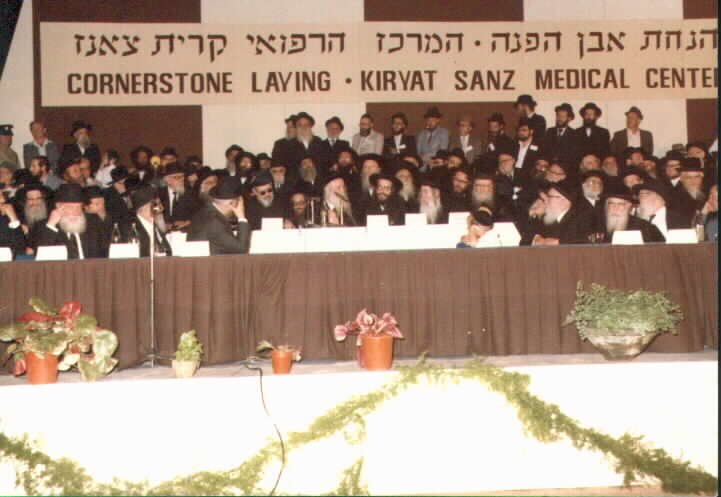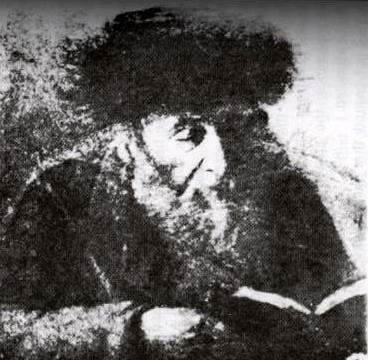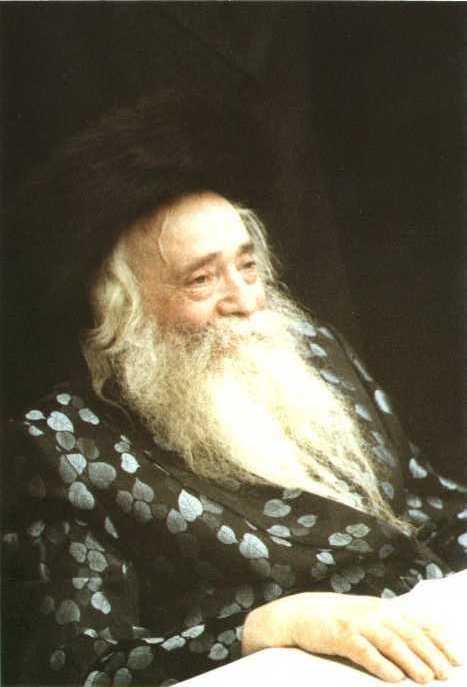|
Zvi Elimelech Halberstam
Zvi Elimelech Halberstam (born 1952) is the present Sanz Rebbe of Netanya, Israel. He is also known as the Sanzer Rebbe. He is the eldest son of Rabbi Yekusiel Yehudah Halberstam, the first Sanz-Klausenberger Rebbe, who in his will divided the leadership of the Klausenburger Hasidim between his two sons, Rabbi Zvi Elimelech and Rabbi Shmuel Dovid (the present Sanz-Klausenburger Rebbe of Brooklyn). He holds his court in the Kiryat Sanz, Netanya neighborhood founded by his father. Biography Halberstam was a child of his father's second marriage in 1947 to Chaya Nechama Ungar, the orphaned daughter of the Nitra Rav, Rabbi Shmuel Dovid Ungar.Landesman, Yeruchem. ''The Wedding that Changed Despair to Hope''. Mishpacha, 11 November 2009, pp. 30-34. This marriage produced two sons — Rabbi Zvi Elimelech and Rabbi Shmuel Dovid — and five daughters. Leadership Upon his father's death in 1994, Rabbi Zvi Elimelech became the spiritual leader of the Sanz community in Israel. He is ... [...More Info...] [...Related Items...] OR: [Wikipedia] [Google] [Baidu] |
Yekusiel Yehudah Halberstam
Yekusiel Yehudah Halberstam (January 10, 1905 – June 18, 1994) was an Orthodox rabbi and the founding rebbe of the Sanz-Klausenburg Hasidic dynasty. Halberstam was one of the youngest rebbes in Europe, leading thousands of followers in the town of Klausenburg, Romania, before World War II. His wife, eleven children and most of his followers were murdered by the Nazis while he was incarcerated in several concentration camps. After the war, he moved to the United States and later Israel. Halberstam rebuilt Jewish communal life in the displaced persons camps of Western Europe. He also re-established his dynasty in the United States and Israel. Halberstam founded a Haredi neighborhood in Israel and a Sanz community in the United States. Additionally, Halberstam established a hospital in Israel that followed Jewish law. He also started a new family after a second marriage and the birth of seven more children. Early life Yekusiel Yehudah Halberstam was born in 1905 in the town of ... [...More Info...] [...Related Items...] OR: [Wikipedia] [Google] [Baidu] |
Safed
Safed (known in Hebrew language, Hebrew as Tzfat; Sephardi Hebrew, Sephardic Hebrew & Modern Hebrew: צְפַת ''Tsfat'', Ashkenazi Hebrew pronunciation, Ashkenazi Hebrew: ''Tzfas'', Biblical Hebrew: ''Ṣǝp̄aṯ''; ar, صفد, ''Ṣafad''), is a city in the Northern District (Israel), Northern District of Israel. Located at an elevation of , Safed is the highest city in the Galilee and in Israel. Safed has been identified with ''Sepph,'' a fortified town in the Upper Galilee mentioned in the writings of the Roman Jewish historian Josephus. The Jerusalem Talmud mentions Safed as one of five elevated spots where fires were lit to announce the Rosh Chodesh, New Moon and festivals during the Second Temple period. Safed attained local prominence under the Crusaders, who built a large fortress there in 1168. It was conquered by Saladin 20 years later, and demolished by his grandnephew al-Mu'azzam Isa in 1219. After reverting to the Crusaders in a treaty in 1240, a larger fortress wa ... [...More Info...] [...Related Items...] OR: [Wikipedia] [Google] [Baidu] |
Hasidic Rabbis In Israel
Hasidism, sometimes spelled Chassidism, and also known as Hasidic Judaism (Ashkenazi Hebrew: חסידות ''Ḥăsīdus'', ; originally, "piety"), is a Jewish religious group that arose as a spiritual revival movement in the territory of contemporary Western Ukraine during the 18th century, and spread rapidly throughout Eastern Europe. Today, most affiliates reside in Israel and the United States. Israel Ben Eliezer, the "Baal Shem Tov", is regarded as its founding father, and his disciples developed and disseminated it. Present-day Hasidism is a sub-group within Haredi Judaism and is noted for its religious conservatism and social seclusion. Its members adhere closely both to Orthodox Jewish practice – with the movement's own unique emphases – and the traditions of Eastern European Jews. Many of the latter, including various special styles of dress and the use of the Yiddish language, are nowadays associated almost exclusively with Hasidism. Hasidic thought draws heavily ... [...More Info...] [...Related Items...] OR: [Wikipedia] [Google] [Baidu] |
Rebbes Of Sanz-Klausenberg
A Rebbe ( yi, רבי, translit=rebe) or Admor ( he, אדמו״ר) is the spiritual leader in the Hasidic movement, and the personalities of its dynasties.Heilman, Samuel"The Rebbe and the Resurgence of Orthodox Judaism."''Religion and Spirituality (Audio)''. UCTV, 20 Oct 2011. web. 31 Jul 2013. The titles of Rebbe and Admor, which used to be a general honor title even before the beginning of the movement, became, over time, almost exclusively identified with its Tzaddikim. Terminology and origin Usage Today, ''rebbe'' is used in the following ways: # Rabbi, a teacher of Torah – Yeshiva students or ''cheder'' (elementary school) students, when talking to their teacher, would address him with the honorific ''Rebbe'', as the Yiddish-German equivalent to the Hebrew word ''rabbi'' ( ' ). # Personal mentor and teacher—A person's main Rosh Yeshiva, Yeshiva teacher, or mentor, who teaches him or her Talmud and Torah and gives religious guidance, is referred to as ''rebbe'' () ... [...More Info...] [...Related Items...] OR: [Wikipedia] [Google] [Baidu] |
Haredi Judaism
Haredi Judaism ( he, ', ; also spelled ''Charedi'' in English; plural ''Haredim'' or ''Charedim'') consists of groups within Orthodox Judaism that are characterized by their strict adherence to ''halakha'' (Jewish law) and traditions, in opposition to modern values and practices. Its members are usually referred to as ultra-Orthodox in English; however, the term "ultra-Orthodox" is considered pejorative by many of its adherents, who prefer terms like strictly Orthodox or Haredi. Haredi Jews regard themselves as the most religiously authentic group of Jews, although other movements of Judaism disagree. Some scholars have suggested that Haredi Judaism is a reaction to societal changes, including political emancipation, the ''Haskalah'' movement derived from the Enlightenment, acculturation, secularization, religious reform in all its forms from mild to extreme, the rise of the Jewish national movements, etc. In contrast to Modern Orthodox Judaism, followers of Haredi Judaism ... [...More Info...] [...Related Items...] OR: [Wikipedia] [Google] [Baidu] |
Sanz (Hasidic Dynasty)
Sanz (or Tsanz, yi, צאנז) is a Hasidic dynasty originating in the city of Sanz ( Nowy Sącz) in Galicia. The dynasty was founded by the rebbe Rabbi Chaim Halberstam (1793–1876) who was the rabbi of Nowy Sącz and the author of the work ''Divrei Chaim'' by which name he is known as well. Rabbi Chaim was a disciple of Rabbi Naftali Zvi of Ropshitz. He opened his court after the death of Rabbi Asher Yeshaya of Ropshitz, son-in-law of Rabbi Naftali Tzvi. After his demise (25 Nisan 5636, 19 April 1876), his six sons and his seven sons-in-law built courtyards with new names in the cities where they served as rabbis, and their chassidim separated, but most of them went to his eldest son, Rabbi Yechezkel Shraga Halberstam of Shinova. His fourth son, Rabbi Aharon, remained to serve as rabbi and rebbe in Sanz, but he was known as the 'Rav of Kreiz', that is, the rabbi of the province, a title he already had in his father's life. In the generations that followed, there were ... [...More Info...] [...Related Items...] OR: [Wikipedia] [Google] [Baidu] |
Klausenberg (Hasidic Dynasty)
Klausenburg, also known as Sanz-Klausenburg, is a Hasidic dynasty that originated in the Transylvanian city of Cluj-Napoca (german: Klausenburg, hu, Kolozsvár), today in Romania. At the behest of Rabbi Yekusiel Yehudah Halberstam, Klausenburger Rebbe from 1927–1994, the movement was split into two separate movements after his death, headed by his two sons. The Sanz-Klausenburger Hasidim are located in Borough Park, New York City, while the Sanzer Hasidim are based in Kiryat Sanz, Netanya, Israel. There are also followings in Los Angeles, California; Jerusalem; Stamford Hill, London; Antwerp; and Union City, New Jersey, and in the USA, in Borough Park, Williamsburg, Monsey, and Lakewood. Sanz-Klausenburg rabbinical lineage The Klausenburger Rebbes are descended from Rabbi Chaim Halberstam of Sanz, who was a disciple of Rabbi Naftoli Tzvi of Ropshitz. Rabbi Naftoli was a disciple of Rebbe Elimelech of Lizhensk author of ''Noam Elimelech''. Rebbe Elimelech was a discipl ... [...More Info...] [...Related Items...] OR: [Wikipedia] [Google] [Baidu] |
Laniado Hospital
Laniado Hospital, also known as the Sanz Medical Center, is a voluntary, not-for-profit hospital in Kiryat Sanz, Netanya, Israel, serving a regional population of over 450,000 in Netanya and the Sharon plain. Opened in 1975 by Rabbi Yekusiel Yehudah Halberstam, the first Klausenburger Rebbe, Laniado Hospital is run according to Jewish law and is known as the only hospital in Israel which has never closed due to a strike. It is administered by the Sanz-Klausenburg Hasidic dynasty under the direction of the present Sanz-Klausenburger Rebbe in israel, Rabbi Zvi Elimelech Halberstam. Though it is not a major emergency-care center, Laniado served a critical role as a triage hospital during more than 20 Netanya-area suicide bombings and terrorist attacks in the Second Intifada.Hall, Y. (1 February 2006). ''The Hospital with a Jewish Heart''. Hamodia Magazine, pp. 12-13, 17. The worst of these was the 2002 Passover massacre at the Park Hotel, located three minutes from the hospit ... [...More Info...] [...Related Items...] OR: [Wikipedia] [Google] [Baidu] |
The Jewish Press
''The Jewish Press'' is an American weekly newspaper based in Brooklyn, New York, and geared toward the Modern Orthodox Jewish community. It describes itself as "America's Largest Independent Jewish Weekly". ''The Jewish Press'' has an online version which is updated daily and reportedly has a readership of 2 million views each month. History The ''Press'' was founded in 1960 by Rabbi Sholom Klass, a Yeshiva Torah Vodaath graduate who had grown up in Williamsburg and who previously co-published the ''Brooklyn Daily''. In 1994, Klass stated that the ''Press'' would not accept advertising from the United Jewish Appeal, describing it as subsidies for competitors. The current editor, since late May of 2021, is Shlomo Greenwald, a grandson of the founders of the publication. Elliot Resnick served as the paper's chief editor until May of 2021. It is believed he was replaced due to the controversy of Resnick entering the United States Capitol on January 6, 2021, and then not indi ... [...More Info...] [...Related Items...] OR: [Wikipedia] [Google] [Baidu] |
El'ad
El'ad, also spelled Elad ( he, אלעד), is a city in the Central District of Israel. In the 1990s, it was built for a Haredi Jewish population and to a lesser extent, it was also built for a Religious Zionist Jewish population. Located about east of Tel Aviv on Route 444 between Rosh HaAyin and Shoham, it had a population of in . El'ad is the only locality in Israel officially designated a religious municipality. The name El'ad means "Forever God", but it is also named after a member of the tribe of Ephraim, who lived in this area (1 Chronicles 7:21). History During the 18th and 19th centuries, El'ad was the site of the Arab village of Al-Muzayri'a. It belonged to the Nahiyeh (sub-district) of Lod that encompassed the area of the present-day city of Modi'in-Maccabim-Re'ut in the south to the present-day city of El’ad in the north, and from the foothills in the east, through the Lod Valley to the outskirts of Jaffa in the west. This area was home to thousands of inhabitant ... [...More Info...] [...Related Items...] OR: [Wikipedia] [Google] [Baidu] |
Beitar Illit
Beitar Illit ( he, בֵּיתָר עִלִּית; officially Betar Illit; "Illit" is pronounced "ee-leet"; ar, بيتار عيليت) is an Haredi Jewish-Israeli settlement organized as a city council in the Gush Etzion settlement bloc, southwest of Jerusalem in the West Bank. Beitar Illit is one of Israel's largest and most rapidly growing settlements, and in had a population of . The international community considers Israeli settlements in the West Bank illegal under international law, but the Israeli government disputes this. Name Beitar Illit (lit. Upper Beitar) is named after the ancient Jewish fortress city of Betar, whose ruins lie away. There also exists a Palestinian village with the name Battir, adjacent to the ruins of the ancient city of Betar. History According to the ARIJ, Beitar Illit was established in 1985 on land which Israel had confiscated from two nearby Palestinian villages: 3,140 dunams from Husan and 1,166 dunams from Nahalin. It was establi ... [...More Info...] [...Related Items...] OR: [Wikipedia] [Google] [Baidu] |
Modiin
Modi'in-Maccabim-Re'ut ( he, מוֹדִיעִין-מַכַּבִּים-רֵעוּת) is an Israeli city located in central Israel, about southeast of Tel Aviv and west of Jerusalem, and is connected to those two cities via Highway 443. In the population was . The population density in that year was 1,794 people per square kilometer. The modern city was named after the ancient Jewish town of Modi'in, which existed in the same area. Modi'in was the place of origin of the Maccabees, the Jewish rebels who freed Judea from the rule of the Selucid Empire and established the Hasmonean dynasty, events commemorated by the holiday of Hanukkah. The modern city was built in the 20th century. A small part of the city (the Maccabim neighborhood) is not recognized by the European Union as being in Israel, as it lies in what the 1949 Armistice Agreement with Jordan left as a no man's land, and was occupied in 1967 by Israel after it was captured from Jordan together with the West Bank pro ... [...More Info...] [...Related Items...] OR: [Wikipedia] [Google] [Baidu] |







.png)

